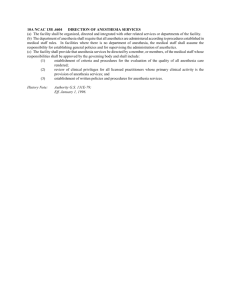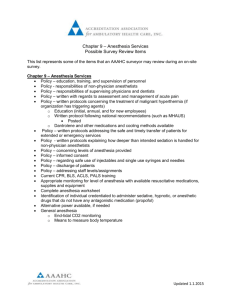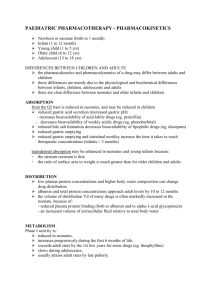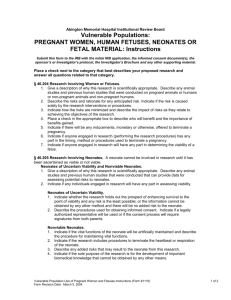Anesthesia And The Neonate
advertisement
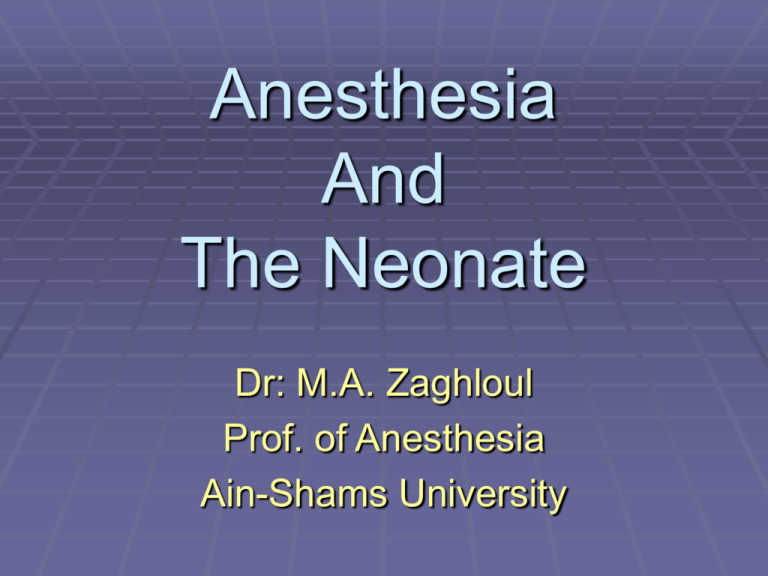
Anesthesia And The Neonate Dr: M.A. Zaghloul Prof. of Anesthesia Ain-Shams University Main differences Between Adults and Neonates 1- METABOLISM The resting O2 consumption of the neonate is double that of the adult ( 6 ml/kg/min ). CO2 production is also doubled. So pulmonary ventilation must be increased ( RR of neonate is 50 ± 10 ). If resp. obstruction occurs, neonates become seriously hypoxic in about half the time than adults. They are more susceptible to lack of food & water & become more rapidly hypoglycemic & dehydrated. Neonates have high resting C.O. to supply enough O2 & remove metabolites. 2- Respiratory System Neonates are obligate nasal breathers. The combination of small nares & large tongue, abundant lymphoid tissue, big head, short neck, increases susceptibility of air way obstruction. The long, narrow, omega, shaped epiglottis & more cephalad vocal cords makes intubation more difficult. The narrowest part of upper airway is opposite cricoid cartilage ( up to 10 years). A rough estimate of endotracheal tube size is: Diameter (mm) = Age/4 + 4 (above 4y) Or ID = ( 16 + age )/4 over 2 y The length of neonatal trachea 2.5 cm. Nasal tubes need to be longer by 2 cm. 3- Pulmonary Ventilation Because of horizontally placed, flexible ribs & relatively underdeveloped intercostal muscles they are diaphragmatic breathers & susceptible to ventilatory embarrassment by abdominal distension. The diaphragm can fatigue under repeated stress especially in prematures. The alveolar bed is incompletely developed at birth, it reach adult type by 8 years. Tidal vol. are the same as in adults on terms of cc/kg, but O2 reserve during apnea is smaller . Age dependent Respiratory variables NB 6m 1y 5y RR(b/min) 50±10 30±5 24±6 18±5 TV (ml) 21 45 78 270 MV(L/min) 1 1.35 1.8 5.5 AV(ml/min) 385 1245 1800 DS/TV 0.3 0.3 0.3 0.3 O2 consump.6 -8 ml/kg/min Pa co2 (mmHg) 30 - 35 30 - 40 30 Pa O2 (mmHg) 60-90 80 -100 80 - A 12 575 6.4 3100 0.3 3-4 40 100 4- Heat loss & Temperature Controle There is increased heat loss & decreased heat production up to 6m of age. A- HEAT LOSS Great surface area in relation to body weight. Preterms has less subcutaneous fat. Evaporation from exposed wound. Infusion of cold fluids. B- Heat production Newborns are unable to shiver. Reduced metabolism of brown fat & carbohydrates due to block sympathetic system by GA. Hypothermia may cause difficulty in reversing muscle relaxants, hypoglycemia &. lactic acidosis 5- CIRCULATORY SYSTEM The resting C.O. is 2-3 times of adults. The resting H.R. is variable ( 110 – 160 ). The resting blood volume is about 85 ml/kg. The haemoglobin is high (16 – 18 gm/100ml). Blood should be given if 10% of bl. vol. is lost & should be accurate. Give Ca gluconate (0.1 of 10% sol./10 ml bl.). Age Related Circulatory Variables HR (b/min) SBP(mmHg) DBP(mmHg) SV(ml/b) CI(L/min/m2) Hb(g/dl) NB 133 80 46 4.5 2.5 16.5 6m 120 90 60 7.5 2 11.5 1y 5y 120 90 96 95 66 55 11.5 27.5 2.5 3.7 12 12.5 A 75 120 80 85 3.7 14 Normal & Accepted Hematocrit Value In Pediatric Patient Age Normal Accepted ( mean/range) Premature NB 3m 1y 6y 45 (40-45) 54 (45-65) 36 (30-42) 38 (34-42) 38 (35-43) 35 30 - 35 25 20 – 25 20 - 25 6- Water And Electrolyte Balance Water electrolyte turnover in neonate is 2 – 3 times of the adult. However the ability to deal with excess or deficiencies is less ( immature renal function). Age And Distribution of Body Water ECF ICF Neonate 40% 35% of BW Adult 20% 40% of BW 7- Renal Function Renal Function of Infants, Children & Adults GFR U.cl. Urine exc. ml/min/1.73m2 ml/min/1.73m2 Term 6m 1y 3y Adult 38.5 110 117.5 127 127 36 22-46 17 75 75 ml/24 h. 15 – 60 250 – 450 500 – 600 500 – 600 500 – 600 Neonates have difficulty in reabsorbing bicarbonate from their urine. Which results in persistent metabolic acidosis. By 6 m, renal function is 80 – 90 % of adult. Sodium loading & conservation is not efficient in neonates. Weight And Hourly Fluid requirements Wt. (Kg) < 10 10 - 20 > 20 Fluid (ml/h) 4 ml/Kg 40 + 2 ml/kg > 10 60 + 1 ml/kg > 20 Fluid Replacement Clinical situation vol.( ml/Kg/h) Intra-abdominal S. 2 Peritonitis/Perforation 4 Two cavity S. 6 • Halve of the deficit fluid is given in the 1st hour& the other ½ is divided equally in the subsequent 2 hours Clinical Significance Of Dehydration Sig. Poor skin turg., dry mouth Sunken font.,tachycard.,olig. Sunken eyes & fontanel's Coma Estimated vol. loss(%) 5 10 15 20 HYPOGLYCEMIA The 1st day of the baby have low BG level & low glycogen stores in the liver. It may be necessary to estimate BG conc. during anesthesia & give 10% G if needed. Normal BG of full term neonate is 60 – 80 mg/dl Hypoglycemia if < 30 mg/dl in FT. Hypoglycemia if < 20 mg/dl in preterm, which is common especially if BW< 2.5 Kg. Caloric Requirements Up to 10 Kg = 100 cal/Kg/day 10–20 Kg = 1000 cal+50 cal/Kg/day for each Kg >10 > 20 Kg = 1500 cal+20 cal/Kg/day for each Kg >20 Drugs In Pediatric Anesthesia Always Remember That NB Has: Higher metabolic rate. More water content, 75% ( more vol. of dist.). Less plasma & tissue protein. Lesser fat & muscle. Large dist. of C.O. to vessel rich tissue. Uptake of inhalation agents is more rapid. Diminished liver & kidney function. NB are sensitive to CNS depressants. Intramuscular absorption is unreliable. Preoperative Evaluation History: course of preg. Mode of deliver, premature labor, sickle cell dis.,….. NB of IDDM have a sig. decrease in myocardial contractility in 1st few days of life. There is sig. dep. Of neonates if the mother received large doses of narcotics or MgSo3 . Evaluation of organ systems is necessary. Premedication The only premedication is atropine < 10 Kg. Older children IM opiates + atropine or hyoscine are commonly used. Ketamine is also commonly used in children but not neonates. Induction Of Anesthesia Awake intubation. Inhalational induction. IV induction. Maintenance Of anesthesia Inhalational + MR + CMV. Reverse MR at the end of surgery. Awake extubation. Return to incubator. Monitoring Precordial stethoscope. BP with suitable cuff size. ( width of cuff = 2/3 length of arm ) IBP through umbilical artery catheter in NB. ECG. Oxygen saturation. End-tidal CO2 . Inspired O2 conc. Temperature. Doses of Some Drugs Used In Pediatric Anesthesia Atropine 0.01mg/Kg Morphine 0.1mg/Kg Meperidine 1mg/Kg Prostigmine 0.02 – 0.04 mg/Kg + atropine 0.02 -0.03 mg/Kg Caudal Anesthesia Use 23 gauge & ¾ inch long needle. For cont. Epidural a 22 g cannula can be used. The dose of Lidocaine calculated by the equation: y = 0.056 × BW (Kg ) It produce analgesia up to T 6 – 8. Or ½ ml/Kg of 1.5 % lidocaine. Infants have less toxicity than adults. Always Remember That: Our 1st responsibility in any critically ill patient is to resuscitate & then give anesthesia as tolerate. NB feel pain as children & adults. It is unacceptable technique to give only MR in NB even if stable. Always monitor fluid balance and keep IV fluids warm.





